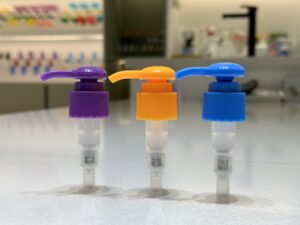Ọrụ bụ isi nke plastik
1.Nchedo akara
Mpempe akwụkwọ plastik’ Ọrụ bụ isi bụ iji hụ na karama nke ọma, na-egbochi ikuku, mmiri mmiri, nje, na ihe ndị ọzọ dị na mpụga site na imetọ ngwaahịa dị n'ime. Mpempe akwụkwọ plastik bụ nnukwu ụzọ iji debe ihe onunu, condents, na ịchọ mma dị ọhụrụ na nchekwa.
2.AJIRI EGO
A na-ejikarị onye ọrụ, na njirimara dị ka usoro mgbochi na usoro dị mfe. Ozoro, ụfọdụ mpempe akwụkwọ plastic gụnyere wụsa spouts, tụọ akpịrị, na atụmatụ ndị ọzọ, nke meziwanye uru ngwaahịa.
3.Ngosipụta ika
Mpempe akwụkwọ plastik na-aba uru na ndị na-ebu oke. Mpempe akwụkwọ plastik, nke bipụtara akara ngosi, Ozi Ngwaahịa, Ntuziaka ojiji, na ihe ndi ozo, Ọ bụghị naanị na-eweta ndị ahịa na ozi achọrọ, kama melite mmata na nkesa.
Ngwa ọhụrụ nke eriri plastik
1.Smart Cas
Smart Cas na-aghọkarị ndị a na-ahụkarị dị ka ọganihu Teknụzụ. A na-ejikwa caphe ndị a, CPU, na ihe ndị ọzọ nwere ike soro parameters dị ka ngwaahịa ngwaahịa na nrụgide ozugbo ma ziga data na ngwa eji ekwentị, Ikwe ka ndị ahịa ghọta ma jikwaa ọnọdụ ngwaahịa.
2.Igwe Eco-Ebi
Seconselọ ọrụ gburugburu ebe obibi nwere ndị omekome plastik ka ha nyochaa ihe na teknụzụ mara mma. Ojiji nke plastik biodegrable, Ntinye aka plastik, Ihe ndị ọzọ metụtara gburugburu ebe obibi agbanweela mmetụta na-emerụ ahụ nke mpempe akwụkwọ plastik na gburugburu ebe obibi. Ozoro, Folsfọdụ ụlọ ọrụ na-ele anya na atụmatụ dị mfe ma belata ojiji rọba iji belata ọnụahịa mmepụta na mmetụta gburugburu.

Recycling na Ruse nke rọba
Ntugharị ma na-echigharịkwa ọtụtụ nlebara anya dị ka akụkụ nke njikwa mkpofu plastik. Ọtụtụ mba na mpaghara enwetarala usoro nrụpụta plastic na-anakọta, nkeocha, anu aru, na recycle mkpofu plastik dị ka eriri plastik. Ozoro, Ọtụtụ ndị na-azụ ahịa na-enyocha teknụzụ kemịkalụ kemịkal maka plastik plastik, nke jiri usoro Chemical eme ihe iji mebie ha na monomers ma ọ bụ Oligomers maka imepụta ngwaahịa plastik ọhụrụ.
Mpempe akwụkwọ plastik, n'agbanyeghị nha ha, jide uru dị mkpa na ọrụ dị ukwuu. Ha abụghị naanị na nchekwa ngwaahịa na ogo ngwaahịa, kama kwalite teknụzụ ọhụụ na mmepe gburugburu. Ọ bụ ezie na anyị hụrụ ohere nke eriri rọba n'anya, Ka anyị tụlee ụzọ ha na-atụgharị uche ma na-atụgharị ihe ịma aka, ka anyị niile nwee ike ịrụkọ ọrụ iji zụlite akwụkwọ ndụ akwụkwọ ndụ, Worldwa na-adịgide adịgide.






